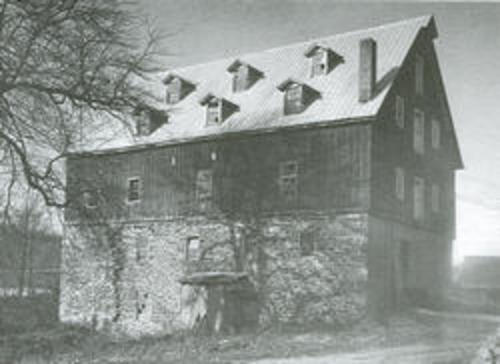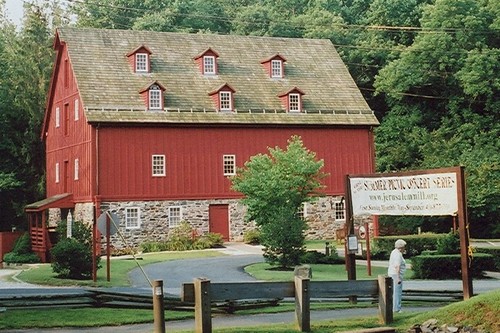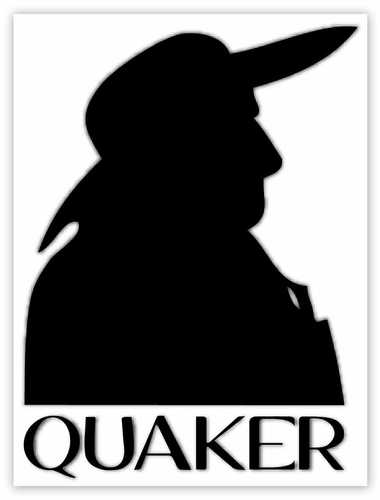Isaiah LINTON (1739-1775)
Welcome to the LINTON Chronicles
Isaiah LINTON (1739-1775)
Master Millwright
page established May 2007 ![]()

Jerusalem Merchant Mill in 1926, Library of Congress Library built in 1772 by Isaiah Linton (1739-1775) master millwright

Anniversary of Jerusalem Merchant Mill
This year 2024 is the 252nd is the anniversary of the building of Jerusalem Merchant Mill by master millwright Isaiah LINTON (1739-1775).
"On August 13, 1772, Isaiah Linton and David Lee entered into agreement said David Lee, miller, living near Joppa, shall enter into the said premises of said Lee's Merchant Mill, and set forth into the milling, grinding, and manufacturing business." David Lee, also, agreed to pay "one-half the said profits, emolument, and advantages, arising from said mill, for a term of four years, to said Isaiah Linton, millwright."
On September 7, 1772, Isaiah and Sarah Linton sold to David Lee a part of Bonds Water Mills, containing a 50-acre mill seat, mill dam, and sawmill. David Lee paid only five shillings for this valuable merchant mill and seat. This sum was just enough to cover the court recording fee.
Isaiah's fourth mill, known as Lee's Merchant Mill and the Jerusalem Merchant Mill, remained in continuous operation for 188 years until 1960 and is standing today, some 252 years later. The Jerusalem Merchant Mill is now under the care of The Friends of Jerusalem Mill and is listed on the National Register of Historic Places. It is the headquarters for the Gunpowder Falls State Park part of the Maryland Park System.
____________________________________________________
Evelyn Virginia BIRD Linton (1922-2012) in front of Isaiah LINTON (1739-1775) Jerusalem Merchant Mill

Master Millwright
Isaiah LINTON (!739-1775)
Master millwright Isaiah Linton is credited with the designing, planning, erection or repairing of eighteen known other water-powered mills and one known iron works in Buck County, Pennsylvania and Baltimore and Hartford Counties, Maryland.
By 1748, nine-year-old, Isaiah had started serving his miller apprenticeship under miller Benjamin Chapman at Chapman's Grist Mill. In 1756, seventeen-year-old, Isaiah Linton started his millwright apprenticeship under the renowned Quaker millwright Richard Mitchell. Isaiah first known project with Richard Mitchell was during the erection of Mitchell's Rush Valley Grist Mill.
In 1758, Isaiah’s first erected water powered mill was the Thompson grist mill on the Neshaminy Creek in Wrightstown Township, Bucks County, Pennsylvania. In 1763, Isaiah erected is second mill, the Worthington Grist Mill in Wrightstown Township on Neshaminy Creek. In 1765, Isaiah erected Thompson’s Grist Mill Core Creek, Middletown Township, Bucks County, Pennsylvania. This mill was later known as Jenk's Grist Mill.
In 1768, Isaiah proceed with the said Commissioned of work Zacheus Barrett Onion, of putting in good repair all of his old and sorry; two forges, two hammers, two water sawmills, furnace, four fires, chair house (carriage house), and said Onion's Forge Grist Mill:" In return, Isaiah was to receive "All of the said Water Rights and Mill Privileges, Lying and Being in the County of Baltimore, Beginning at the Head Waters of the river called Gunpowder, and running up the said Small Branch (Little Gunpowder Falls), of said Gunpowder: to include all and singular smaller Heads of all of its branches, banks, ponds, streams, water courses, river places, ways, paths, and the soil thereof, within said measured-out-distance of 1,600 perches, (approximately five miles), more or less".
By the end of 1769, Isaiah had in operation one grist and two sawmills leased from Onion. Isaiah had also erected his first of eight water-powered mills in Baltimore and Harford Counties. This new stone sawmill was located on the north bank (Harford County), approximately four miles above Joppa Town, where the old Bel Air-Baltimore Rolling Road (Jerusalem Road) crossed the Little Gunpowder Falls. This mill was first known as the Upper Jericho Sawmill, later as the Jerusalem Sawmill.
By September 1770, Isaiah had completed his stone sawmill, which was first known as the Lower Jericho Sawmill, later as the Jericho Sawmill.
In April 1771, Isaiah recorded that he "started grinding Jacob Scott's Indian corn in Jericho Mill." on the Little Gunpowder Falls was first known as the Jericho Merchant and County Mill. It later became known as the Upper Jericho Merchant Mill, then the Jericho Merchant Mill, next Tyson's Grist Mill, next Maryland Cotton Manufactory, next Jericho Cotton Factory Mill, and last it was known as Simms & Company Cotton Manufactory.
By August 1772, Isaiah had erected his Upper Jericho Merchant Mill was located on the north (Harford County) bank of the Little Gunpowder Falls, where it crossed the old Bel Air-Baltimore Rolling Road just behind the Upper Jericho Sawmill. This mill was known as Lee's Merchant Mill for over 100 years, until the mid-1870s, when it became known as the Jerusalem Merchant Mill.
In late 1772, Isaiah had started the erection of his fifth mill on the Little Gunpowder Falls. This mill was on the south bank (Baltimore County), approximately two miles above Joppa Town and a mile below the Jericho Merchant Mill on the old Bel Air-Joppa Rolling Road, a site now called Franklinville. This mill was first known as the Lower Jericho County Mill and later as Gwin's Custom Grist Mill. Isaiah, on April 7, 1774, leased his new Lower Jericho Custom Mill to Quaker Elisha Tyson of Philadelphia. Elisha Tyson subleased the mill to miller John Thomas, who then sub-leased to miller William Gwin. By late 1781, a bitter feud was raging between Elisha Tyson and William Gwin over the ownership of the lease of Gwin's Custom Mill. This dispute was resolved when Sarah Linton, the widow of Isaiah, on February 25, 1782, sold the Lower Jericho County Mill and Mill Seat, containing 70 acres, to William Gwin. In 1786, the mill was destroyed by a flash flood.
By mid-1773, Isaiah had erected a sixth mill on the Little Gunpowder Falls by dismantling Onion's Forge Sawmill and re-erecting it across the Falls on the south bank (Baltimore County) near Onion's Upper Forge and the Upper Dam and to be erected, and for other buildings and repairs on the said premises of the mill seat." This sawmill was later known as Onion's Merchant Sawmill, located on The Great Road (Maryland State Route 7), where it crossed Little Gunpowder Falls. This sawmill was described as a location where "from the doors of the sawmill, scantling, planks, and timbers could be loaded onto a large batteaux or a scow lying in the river, for shipment to Joppa Town”. This dual powered waterwheel, stone mill was first known as Onion's Merchant Mill, later as Onion's Upper Merchant Mill, then Paul's Merchant Mill, Dallam's Merchant Mill, Hoskin's Mill, and lastly as the Scott & McCoukey Mill. This stone merchant mill, built by Isaiah Linton, was in continuous operation well into the late 1800's.
By the spring of 1775, Isaiah had completed his third mill for Onion and final mill. This 2 ½ story, stone mill was 48 feet long and 38 feet wide. This mill was located down the Falls, on the east side and the north bank (Harford County) where the Philadelphia-Baltimore road crossed Little Gunpowder Falls (The Great Road, Maryland State Route 7). The mill was first known as Onion's Lower Merchant Mill; then as the Mexico Merchant Mill; Hollingsworth's Mill; Diver's Mill; Cook's Mill; Day's Mill, and lastly as the Dieter Grist Mill. It was in continuous operation until the late 1800's.
Isaiah Linton was seriously injured sometime in 1775, during the erection of Onion's Lower Merchant Mill. His accident was later described in detail to the Newtown Township Orphan's Court in Bucks County by his younger brother, William Linton. In 1777, William wrote that Isaiah was "seriously injured in a milling accident, while raising a runner stone, with block and fall, to the first story of the mill, when the timber gave way at the hood, and his left leg was crushed by the stone. There were only children assisting at the time, and the Elders had to be summoned from the fields to roll the stone off, which was embedded on its edge." Isaiah's "left leg was removed" and he "lost the sight from his left eye" and was later "aided by a peg." On November 26, 1775, millwright Isaiah Linton died suddenly from "complications received in a milling accident." William Linton was appointed administrator of Isaiah's estate and guardian of his five small children. In February 1776, Isaiah's widow Sarah and her children moved back to Isaiah's plantation in Bucks County. As administrator, William put Isaiah's remaining lease terms up for sale at public auction. Over the next ten years, William disposed of and settled all of Isaiah's lands, mills, and mill leases, both in Maryland and Pennsylvania.
__________________________________________________________________
Jerusalem Mill in 1989 photo taken by Diane Marie BOURLAND Linton
_photo_by_diane_marie_bourland_robinson_linton_340x500.jpg)
Isaiah LINTON (1739-1775)
Legacy
Terry Louis Linton © 2024
Linton Research Fund Inc., Publication © 2024
LINTON Chronicles Volume XVIV, Issue 2, Summer © 2024, ISSN 1941-3521
____________________________________
According to various county court records in Pennsylvania and Maryland, Isaiah LINTON (1739-1775) was described as a “good father, a learned man, miller, millwright, skilled master-builder, skilled master millwright, skilled engineer, a good and honest miller, yeoman, gentleman, planter, farmer, Quaker Elder, Quaker Meeting Prothonotary, co-founder of Newtown Library”.
Isaiah LINTON (1739-1775) was the 3rd great grandfather of Kirk Louis LINTON (1914-1987) and the 4th great-grandfather of Kenneth “Ken” Edward LINTON & Terry Louis LINTON.
Isaiah was the son of the Quakers John LINTON Jr., (1706-1761) & Elizabeth HAYHURST (1709-1795). Isaiah was born on January 15, 1740, in Wrightstown Township, Bucks County, Pennsylvania, died on November 26, 1775, in Joppa, Hartford County, Maryland, at age 36. He was buried on November 28, 1775, in the Forest Quaker Meeting House Yard, Baltimore County, Maryland.
Isaiah married Sarah HIRST (1742-1823) the daughter of John HIRST (1720-1754) emigrant and Quaker preacher & Mary Anna JARRETT (1712-1802) emigrant, on October 24, 1764, in Wrightstown Township, Quaker Meeting House, Bucks County, Pennsylvania. Sarah was born on February 23, 1742, in Wrightstown Township, Bucks County, Pennsylvania. Sarah died on June 19, 1823, in Wrightstown Township, Bucks County, Pennsylvania at age 81. She was buried on June 21, 1823, in the Wrightstown Quaker Meeting House Cemetery, Bucks County, Pennsylvania.
Isaiah was educated in the Quaker tradition, "based on the conviction that education must make one familiar with the spiritual forces surrounding their life, understanding the problems of social life, and to understand the workings of one's indulged profession.'' Isaiah first attended the Chapman's Quaker School, located in Wrightstown Township, for his basic education. Then at age fourteen, Isaiah attended the Quaker Business School of Philadelphia. It was uncommon for a Quaker youth to attain a higher education at such an early age.
Isaiah followed the Quaker belief "of furthering one's own education and that of others by the reading of books." On August 9, 1760, Isaiah and nine other Quakers organized The Newtown Library Company, located in Joseph Thornton's Court Inn Tavern. This collection of books and the Newtown Library Company are still in existence today in Newton, Bucks County. At the time of Isaiah's death, his personal library contained the following valuable books: Homer's Iliad and Odyssey, by Pope; Rollin's History in Ten Volumes: One Time, by Burnotes; Bell's Letters: Register and Letters, by Actken: Baily's Dictionary; and one old Bible.
Even though Isaiah lived only 36 years, he left a legacy of involvement in the revitalization of Joppa Town. He also left the involvement in eighteen known mills, one known iron works, and numerous dwellings and outbuildings. Many of his mills and dwellings and outbuildings still stand as testimony to the engineering ability of Isaiah of Bucks County, Pennsylvania, and Baltimore and Harford Counties, Maryland.
Linton Research Fund Inc., Publication © 1987-2024 "Digging for our Roots"
"We exist because of our ancestors, let try not to forget them"

______________________________________________________
The Forgotten Millwright, Isaiah Linton (1739-1775)
Master millwright Isaiah LINTON (1739-1775) (Brief Historical Sketch)
Master Millwright Isaiah LINTON (1739-1775)
Master millwright Isaiah LINTON (1739-1775) (3rd great-grandfather of Kirk Louis LINTON (1914-1987)
How are you related to Isaiah LINTON (1738-1775)
Master millwright Isaiah LINTON (1739-1775) (Brief Lineage Heritage)
LINTON Family Facts Brief Historical Sketches Isaiah Linton (1739-1775) Prothonotary
Isaiah's Jerusalem Mill Page
Gunpowder Falls State Park Jerusalem Mill History
The Friends of Jerusalem Mill Gunpowder Falls State Park
Historic Jerusalem Mill Village on Facebook
The Society for the Preservation of old mills (SPOOM)
Main Menu
Linton Research Fund, Inc., HOME PAGE
LINTON Chronicles Table of Contexts
LINTON Ancestors in the Revolutionary
LINTON Ancestors in the Civil War 1861-1865
BIRD Chronicles Table of Contents
Bird Ancestors in the Revolutionary War
BIRD Ancestors in the Civil War 1861-1865
Today's Birthdays & Anniversaries
History of the Linton Research Fund Inc., LINTON & BIRD Chronicles
LINTON & BIRD Chronicles on Facebook
![]() "Thanks for Visiting, come back when you can stay longer" Terry Louis Linton © 2007
"Thanks for Visiting, come back when you can stay longer" Terry Louis Linton © 2007
Linton Research Fund Inc., Publication © 1987-2024 “Digging for our roots”
LINTON & BIRD Chronicles
Established 1984
Quarterly Publication of the Linton Research Fund Inc. ![]()
